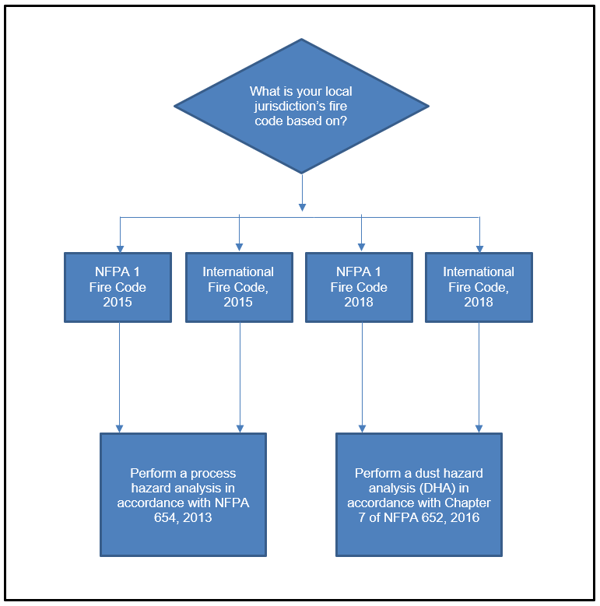Why Do I Have to Perform A Dust Hazard Analysis (DHA)?
by Ash Kreider on Nov 9, 2021 10:30:00 AM

Introduction
If your facility handles dust, you have likely heard about NFPA 652, “Standard on the Fundamentals of Combustible Dust” and the dust hazard analysis (DHA) that it requires. You may be asking yourself why you need to follow this standard. Protecting your employees and facility from a fire, flash fire, explosion or deflagration spring readily to mind, but there are regulatory reasons as well. This article focuses on the regulations that require evaluating your facility for dust.
Your Local Fire Code Requires It
Before diving into the code references, we need to talk about how codes are adopted. Codes are adopted at state or local levels. In general, legislative bodies adopt a model building code from a well-established standards organization then add amendments to better suit the location. There are many codes published, i.e. plumbing, building, energy, mechanical, residential, etc. With respect to combustible dust, the relevant fire code is the starting point. In the United States, there are two widely used fire codes:
- The National Fire Protection Association (NFPA) publishes NFPA 1, Fire Code
- The International Code Council (ICC) publishes the International Fire Code (IFC)
Both NFPA and ICC publish their fire code every three years, the latest editions are 2015 and 2018 for both organizations. Local jurisdictions adopt a specific publication year through legislative action and update the adopted publication year regularly. The result of this is that local jurisdictions do not always adopt the most recent publication. For example, the current Vermont fire code is the 2015 Fire & Building Safety Code which adopts NFPA 1, 2015.
This article would get tedious if I were to review the fire code for every jurisdiction in the United States, so I will focus on 4 of the most widely adopted codes:
- NFPA 1, Fire Code, 2018
- International Fire Code (IFC), 2018
- NFPA 1, Fire Code, 2015
- International Fire Code (IFC), 2015
The 2018 versions of both NFPA 1 and the International Fire Code explicitly require a NFPA 652 dust hazard analysis using similar language:
- NFPA 1 2018 40.3.1: “Existing facilities shall perform a dust hazard analysis (DHA) in accordance with Chapter 7 of NFPA 652.”
- International Fire Code, 2018 2203.2: “The requirements of NFPA 652 apply to all new and existing facilities and operations with combustible dust hazard. Existing facilities shall have a dust hazard analysis (DHA) completed in accordance with Section 7.1.2 of NFPA 652.”
The 2015 versions of both NFPA 1 and the IFC do not directly require a dust hazard analysis, but they do require a similar analysis. These codes reference NFPA 654, the “Standard for the Prevention of Fire and Dust Explosions from the Manufacturing, Processing, and Handling of Combustible Particulate Solids”, 2013 along with other industry specific dust explosion protection standards. This is because NFPA 652 was not published until 2016.
- NFPA 1 2018 40.1 “Equipment, processes, and operations that involve the manufacture, processing, blending, repackaging, or handling of combustible particulate solids or combustible dusts regardless of concentration or particle size shall be installed and maintained in accordance with this chapter and the following standards as applicable:” The provided list includes NFPA 654 and other industry specific dust explosion protection standards.
- International Fire Code, 2018 2204.1: “The fire code official is authorized to enforce applicable provisions of the codes and standards listed in Table 2204.1 to prevent and control dust explosions.” Table 2204.1 includes NFPA 654 and other industry specific dust explosion protection standards.
The 2013 version of NFPA 654 does not use the phrase “dust hazard analysis” but it requires a “process hazard analysis” of the facility, processes and associated fire or explosion hazards. This process hazard analysis required by NFPA 654 is similar to the dust hazard analysis required by NFPA 652. In both cases facilities need to evaluate and document their combustible dust risk.

OSHA Enforcement Actions
There is no OSHA standard on combustible dust, but that does not prevent OSHA inspectors from citing facilities for combustible dust risk. OSHA’s directive CPL 03-00-008 provides guidelines to OSHA inspectors about what to look for with respect to combustible dust risk and how to site violations.
OSHA often sites facilities for what is known as the general duty clause, OSH Act of 1970 Section 5(a)(1). This clause requires employers to provide an environment that is “free from recognized hazards that are causing or are likely to cause death or serious physical harm”. It is used where no OSHA standard already exists. Two other common citations for combustible dust violations are 29 CFR Part 1910.22 (housekeeping) and 29 CFR Part 1910.176 (housekeeping in storage areas).
Although OSHA does not require a dust hazard analysis, citations frequently cite NFPA 652 as one path to reach compliance. This shows that OSHA considers the NFPA codes to be the standard, but leaves the door open for facilities to evaluate their combustible dust risk using a different approach. In either case employers are responsible for evaluating and mitigating their combustible dust risk.
Summary
If your facility handles dust, your fire code requires that you follow NFPA publications to complete a dust hazard analysis. Not evaluating your facility for dust hazards leaves your employees and facility at risk and leaves you open to OSHA enforcement. If you would like to learn more or want to discuss how to start a dust hazard analysis you can contact Ash directly at akreider@Hallam-ICS.com.
About the Author
Ash Kreider is a Mechanical Engineer at Hallam-ICS. He has process engineering experience in multiple industries. He currently designs systems for a wide range of applications including gas distribution, cryogenic fluid recovery, process equipment hookup and HVAC.
Read My Hallam Story
About Hallam-ICS
Hallam-ICS is an engineering and automation company that designs MEP systems for facilities and plants, engineers control and automation solutions, and ensures safety and regulatory compliance through arc flash studies, commissioning, and validation. Our offices are located in Massachusetts, Connecticut, New York, Vermont and North Carolina and our projects take us world-wide.
You May Also Like
These Related Stories

Do You Have An HPM "Junk Drawer"?

From the Plant Floor to OEE Dashboards: How to Harness Your Data




No Comments Yet
Let us know what you think